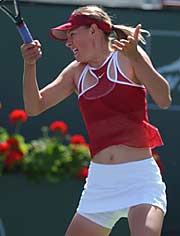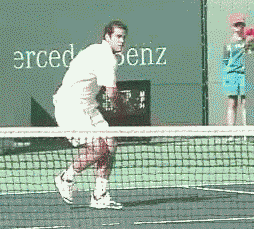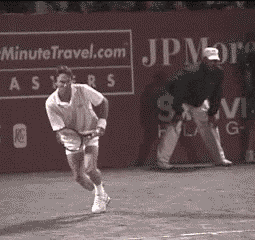|
TennisOne Lessons The Trap Of The Big Point Theory Happy Bhalla The big point theory is an ideal that seems to make sense on a superficial level, and yet on closer examination, proves to be incongruent. The concept that some points are more important than others is a popular one within the tennis community. That it is popular, however, does not make it true. Two perceptions can arise if one buys into the big point theory: one is that the player can become so nervous because he considers the point so huge that he cannot function loosely and freely. The second is that an individual who loves to compete can be motivated by the challenge and thus be spurred to greater heights.
There are very few people who fall into the second category and even those that do must forget the importance of the point as the point begins; they simply use that idea for motivation, to prepare for the coming point. Let us examine this popular concept, which is almost universally accepted as gospel. It is true that tennis is a game where one player can lose more points than he wins and yet win the match. This leads to the seemingly logical conclusion that not all points are worth the same; consequently we have the birth of the big point theory. However, as logical as this sounds, there are a couple of problems with the emphasis on the big point. If one is going to play one's best on a big point, the implication is that on other points one is doing less than their best. Are we willing to accept that we play some points short of our best? Are we comfortable telling juniors not to play every point as hard as they can? How can players raise their game on the big point? They cannot play better than their best, so if they play their best on the those points, then how are they playing the rest of the time?
Brad Gilbert defines a big point as any point that can win a game or any point that if won would lead to a game winning point. This logic is untenable. Imagine a four-rung ladder, from which an apple can be plucked from a tree. The object is to pluck the apple. From the fourth rung one can reach the apple, but unless one climbs the third rung they will not reach the fourth rung; similarly the third rung cannot be reached until one has already arrived at the second and so forth. This metaphor illustrates that climbing each rung is equally important, because one leads to the next. At the very least, we would have to call each point big. Actually they are equally important or equally insignificant, with the emphasis on equal. Another question, which arises, is how can there be twenty or thirty big points per match? Commentators on television call at least one or two points of each game big. By definition winning a big point should give you a huge opportunity to win the match and yet an individual can win many ‘big ‘points and still lose the match. A point should be played on the basis of tangible factors; the height, speed and spin of the ball, where on the court the ball bounces, as well as one's ability to hit certain shots and the opponent's susceptibilities to, or disdain for, certain shots are all factors that determine shot selection. It seems absurd that numerous reputable coaches should advise students to play points based on something as abstract as the score and yet this theory is so accepted that it is considered blasphemy to question it. Even if we are to buy into the fallacy of the big point theory, the problem arises how to play those points.
One theory suggests that on such points one should surprise one's partner on the other side by doing something different. How sensible is it to do something unusual, such as serving and volleying if you are a baseliner? If it is a surprise to your opponent, it is going to be something that you have not tried too often during the match. If you have not tried this particular tactic, it is probably because it is not something you consider your strength. If you were not completely comfortable with this tactic, why would you want to try it on what you consider an important point? Conversely, if you can be successful with this tactic, then it should be sprinkled throughout your match in an unpredictable manner. Remember that an opponent can only be surprised once. Or how about going for a big serve? Does that mean going for a serve that is bigger than you normally hit? Unlikely, because players are trying to hit a first serve as hard as they comfortably can and to hit harder could distort the technique or rhythm and render the chances of success too low. Another theory suggests that one should play within oneself on such points and avoid giving away easy points; however, giving up opportunities to attack allows the opponent to gain the initiative. Other theories abound, but all are similarly unconvincing.
Even if players themselves buy into the big point theory and are successful, my contention is that they are able to put that thought out of their mind when the point begins. Invariably, those who are aware of the importance of a point while the point is in progress will struggle to reach peak performance and be mentally weak in competition. At the very best, the big point theory reminds a player to be present focused, which he or she should be for every point, but once a point begins the player cannot afford the luxury of being aware of anything but the ball and the periphery information directly relevant to playing out the point. For me, someone who plays the ‘big' points well is someone who plays the point as well as they can, but not better than they play other points. In other words, the least affected you are by the magnitude of the up-coming point, the more likely you will play the point to your potential. If you are able to do that, I guarantee you will be considered a big point player. So, the irony is that big point player reputations are made by players who refuse to recognize the big point and therefore play a normal, solid point or by their opponents who do recognize the big point theory and become nervous and play below their potential. Facilitators are more and more looking into statistics to evaluate their players, but while statistics make good television copy, they are very limiting for evaluating players. Each point is different and you can win a point in a variety of ways and yet regardless of how an individual point is won, it just shows up in the win column.
It is unhealthy for youngsters to buy into this theory because to do what is necessary to win will not necessarily help them to develop as tennis players. If I play tentatively on match point and my opponent finally makes an error and I win the match, what have I won? How have I become a better player? What will happen when I play a stronger opponent and he does not make an error, but instead takes my tentatively hit ball and whacks it for a winner? The point is if you get an attackable ball; attack, regardless if it is 15-15 or 15-40. The physical situation you find yourself in should determine your response, not the score. The more you tie into the big point theory, the less chance you will have of being a mentally tough competitor. Instead, play each point with the same psychological mindset, in a state of relaxed intensity (intensity comes from a total commitment, 100 % effort, and the relaxation comes from detachment from the result), and in present focus, waiting to pounce on the first opportunity your opponent presents you. To play in present focus is to be open to the limitless opportunities each moment of play presents. Jimmy Connors was an excellent example of this. He prided himself on playing his best every point, every match and every tournament, regardless of the situation. Unfortunately, this attitude is not typical of all players and that is why they are not as mentally tough as Connors was. |





